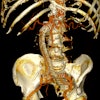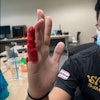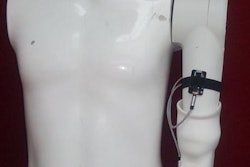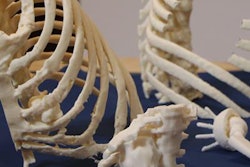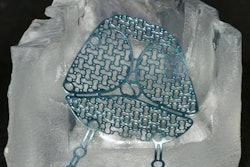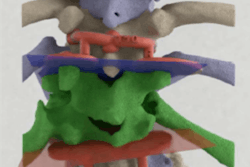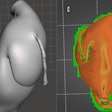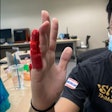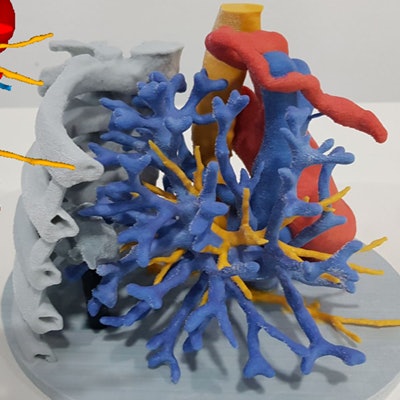
Researchers from Spain have created 3D-printed lung cancer models based on a combination of CT scans and MR images. They explained how to make these hybrid models and also described the advantages of using them to guide tumor removal in an ECR 2018 poster presentation that won a cum laude award.
The group from Hospital Cruz Roja in Córdoba acquired chest CT scans and MR images of several patients with lung cancer and fused them together to create a hybrid 3D-printed model of the lung with tumors. Applying these models intraoperatively decreased the surgical time to remove the cancer.
"[Hybrid] 3D printing constitutes a novel and potentially useful technique available for treatment planning and learning improvement," presenter Dr. Jordi Broncano wrote. "Although its impact is still to be proved, this procedure could improve surgery planning, especially in complex operations."
Hybrid 3D printing
A number of prior studies have shown the value of 3D-printed models for anatomic studies of the chest, device and prosthetic implantation, and the planning and guiding of chest procedures, according to Broncano and colleagues. Usually, these models are 3D representations of either CT scans or MR images acquired in the evaluation of the chest.
 Dr. Jordi Broncano from Hospital Cruz Roja and Hospital San Juan de Dios in Córdoba, Spain.
Dr. Jordi Broncano from Hospital Cruz Roja and Hospital San Juan de Dios in Córdoba, Spain.Clinicians most commonly perform a CT scan in the initial evaluation of lung cancer because it provides excellent anatomic detail of the lungs, whereas they generally favor MRI (rather than PET/CT) for staging lung cancer and detecting metastases, the authors noted.
Seeking to draw from the strengths of both imaging modalities, the investigators obtained the chest CT scans and functional MR images of patients with lung cancer and then fused the scans and images into a single file for hybrid 3D printing.
For the CT protocol, they acquired contrast-enhanced CT scans with a small field-of-view to increase the spatial resolution of the scans and an iterative reconstruction algorithm to diminish image noise. Then they followed vendor-based, semiautomated segmentation protocols to delineate distinct areas of the scans.
After processing the CT scans, they collected MR images of the patients' lungs and merged the corresponding scans and images into a singular file via an advanced visualization platform (IntelliSpace Portal, Philips Healthcare). The process involved using a rigid registration algorithm to align the CT scans with high b-value diffusion-weighted MR images and match the field-of-view for both imaging datasets, as well as manually correcting any errors in positioning.
Finally, they modified the resulting stereolithography (STL) file using an open-source, mesh-modeling software (MeshLab) and constructed the 3D models using a multijet 3D printer (ProJet MJP 5600, 3D Systems).
 Hybrid 3D printing fuses CT scans and MR images to create 3D models of lungs. Image courtesy of Dr. Jordi Broncano.
Hybrid 3D printing fuses CT scans and MR images to create 3D models of lungs. Image courtesy of Dr. Jordi Broncano.Therefore, with an excellent morphologic examination, such as contrast-enhanced CT and MRI, this potentially enables clinicians to represent the whole tumor, node, metastasis staging of one tumor in a 3D printing model, they wrote.
Potentially beneficial
In a prospective case study, Broncano and colleagues evaluated the extent to which a patient-specific, hybrid 3D-printed model of a patient's lung and tumors could help guide surgical removal of the cancer. They completed five partial lobectomies using the 3D-printed models as a guide and compared the outcomes with those of 10 similar surgeries performed without the aid of the models.
On average, applying 3D printing to this surgery resulted in reducing intraoperative time by 30.6 minutes, hospitalization time by 1.9 days, and intubation time by 30.5 minutes (p < 0.05) compared with surgery without referring to 3D-printed models. However, the researchers found no statistically significant difference between the patients' spirometric parameters or in the amount of time they spent in the intensive care unit with either surgical technique.
"Despite the limited statistical power, it seems that 3D printing may have a potential and beneficial impact in the surgical treatment of lung cancer," they concluded.
These potential benefits have encouraged the researchers to expand the population in a continuing study and evaluate the post-treatment effects of using 3D-printed models intraoperatively.
"We are registering short- and midterm follow-up [of patient postoperative recovery] at one month and three months and increasing the power of our cohort to obtain better results," Broncano told AuntMinnie.com.

